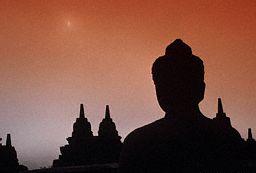|
|
|

TIME-LINE
Please
note that most of below dates are approximations only and inclusion of major developments
has been very arbitrary by the webmaster.
Prehistoric:
Original Indus Valley Civilisation: meditation, asceticism.
1800 - 1500 BCE.: Invasion of Aryans in India: introduction of Vedas,
Brahma, priesthood, caste system, ritual offering.
1500 BCE onwards: development of (pre-) Hindu schools like Mimamsa,
Samkhya, Vedanta.
590-470 BCE: Mahavir - Founder of Jainism, contemporary of the Buddha.
624-560 BCE: Birth of Siddhartha Gautama
589-525 BCE: Enlightenment of the Buddha in Bodhgaya (at age 36). During
the full-moon night of July, the Buddha delivers his first discourse near
Varanasi, introducing the world to the Four Noble Truths and commencing a
45-year career of teaching the religion he called "Dhamma-vinaya".
544-480 BCE: Passing away of Gautama Buddha.
543 -479 BCE: 1st Buddhist Council in Rajaghgraha during the
rains retreat following the Buddha's Parinibbana. 500 Arahant Bhikkhus, led
by Ven. Mahakassapa, gather to recite the entire body of the Buddha's teachings.
The recitation of the Vinaya by Ven. Upali becomes accepted as the Vinaya
Pitaka; the recitation of the Dhamma by Ven. Ananda becomes established as
the Sutta Pitaka. {1,4}
443-379 BCE: 2nd Buddhist Council in Vesali, 100 years after
the Buddha's parinirvana, to discuss controversial points of Vinaya. The first
schism of the Sangha occurs, in which the Mahasanghika school parts ways with
the traditionalist Sthaviravadins. At issue is the Mahasanghika's reluctance
to accept the Suttas and the Vinaya as the final authority on the Buddha's
teachings. This schism marks the first beginnings of what would later evolve
into Mahayana Buddhism.
297 BCE: King Asoka (274-236 BCE) converted to Buddhism; Buddhism developed
from small local group to state religion.
247 (308?) BCE : 3rd Buddhist Council, convened by King Asoka
at Pataliputra (Patan?) India. Disputes on points of doctrine lead to further
schisms, spawning the Sarvastivadin and Vibhajjavadin sects. The two Pitakas
are enlarged to include the Abidhamma, forming the Tripitaka (three baskets.)The
Abhidhamma Pitaka is recited at the Council. The modern Pali Tipitaka is now
essentially complete, although some scholars have suggested that at least
two parts of the extant Canon -- the Parivara in the Vinaya, and the Apadana
in the Sutta -- may date from a later period. Asoka sends missionaries to
Sri Lanka ( his son Mahindra), Kanara, Karnataka, Kashmir, Himalaya
region, Burma, Afghanistan and even Egypt, Macedonia and Cyrene.
240 BCE Sri Lanka: Ven. Mahinda establishes the Mahavihara (Great Monastery)
of Anuradhapura, Sri Lanka. The Vibhajjavadin community living there becomes
known as the Theravadins. Mahinda's sister, Ven. Sanghamitta, arrives in Sri
Lanka with a cutting from the original Bo tree, and establishes the bhikkhuni-sangha
(nuns) in Sri Lanka.
236 BCE India: After death of Asoka, period of persecution of Buddhism
under Pusyamitra Sunga
1st Cent BCE India: Erection of the great Stupa at Sanchi. The Ratnaguna
Samcayagatha--a summary of the Prajna Paramita is written down. This includes
the oldest literal reference to Bodhisattva, Mahasattva, and Bodhiyana.
94 BC Shri Lanka: 4th Buddhist Council (acc. to Theravadins)
at Cave Aloka in Malaya district - see also 2nd Century India for another
'4th Council'.
35 BCE Sri Lanka (or 100BCE?): King Vattagamani
orders the Buddhist teachings (Theravada canon) to be committed to writing.
Division between Mahavira and Abhayagiri vihara in Sri Lanka. 
65 CE China: First historic proof
of Buddhist community.
1st Cent CE Thailand and Burma: monks from Sri Lanka establish Theravada.
2nd Century India: 4th Buddhist Council in Jalandhar, India
under royal patron Kaniska.
2nd Century India: Appearance of Mahayana Buddhism as separate school.
2nd Century China: translators like An Shih-kao began translating Indian
Buddhist texts using mostly Taoist terminology, initially causing many Chinese
to believe that Buddhism was another version of Taoism.
2nd Century Vietnam: First introduction from China, followed by more
missions, both Mahayana and non-Mahayana in 3rd century.
c. 200 India: Buddhist monastic university at Nalanda flourishes; remains
a world center of Buddhist study for over 1,000 years.
2nd-3rd Century India: Master Nagarjuna; known for his profound teachings
on emptiness.
320 to 1000 India: Development of Vajrayana Buddhism, based on Mahayana.
4th Century India: Master Vasubandhu; known for his teachings on mind-only
(Cittamatrin) and worship of Amitabha, desire for rebirth in the Pure Land,
leading to the development of the later Pure Land schools.
4th Century Sri lanka: King Mahasena introduces Mahayana monks.
320 China: Invasion of Huns in China, after which many Buddhist monasteries
were established until 6th Century.
334-416 China: Master Hui: Founder of the White Lotus Movement and
of Pure Land Buddhism in China.
372 Korea: First arrival of Buddhism on the peninsula from China.
4th Century Nepal: from this time onwards, coexistence of Buddhism
and Hinduism, followed Indian traditions.
425 Sri Lanka: Buddhaghosa composes the Visuddhimagga (The Path of
Purity) which eventually becomes the classic Sri Lankan textbook on the Buddha's
teachings.
5th Century China: Founding of Ching-t'u school of Pure Land Buddhism
by T'an Luan (476-542)
5th Century Java, Sumatra, Borneo and Burma; Mahayana Buddhism
was introduced, mainly by Indian immigrants.
480 China: Indian Master Bodhidharma travels as a Buddhist missionary
to China, as follower of the Lanka School he is considered the forefather
of Ch'an and Zen.
499 India: Monks of the Sarvastivadin school decide on new canon.
5th Century Cambodia: mixture of Hindu Shivaism and Mahayana, lasting
until the 11th century. Non-Mahayana schools were also present, but less prominent.
552 Japan: Buddhism enters from China (possibly via Korea?).
550-664 Korea: Buddhism is state religion.
6th Century China: Founding of T'ien T'ai by Chih-I (538-597), also
known as Fa-hua, or lotus school; syncretism of all Mahayana shools.
6th Century Kashmir: invasion of Huns with persecution of monks. After
their departure, slow restoration.
6th and 7th Century Korea: introduction of many Chinese schools.
641Tibet: Buddhism introduced from India, helped by King Song Tsen
Gampo
650 Tibet: first Budhist temple in Tibet
7th century China: Founding of Hua-yen school by Fa-tsang (643-712) -
tantric Buddhism lasted only until about 1000 CE. Founding of Ch'an school
by 6th Patriarch Hui-neng (638-713)
7th Century Cambodia: repression of Buddhism, followed by later strong
support.
7th and 8th Century Kashmir: revival of Buddhism, strong influence
of tantric schools.
710 Japan: capital moved to Nara; development of the 6 Nara-schools
which were highly politisized, leaving them open to corruption.
730 Japan: introduction of Chinese Hua-yen school, known as Kegon in
Japanese.
713-741 China: The T'ang Dynasty Esoteric School was introduced by
the three Mahasattvas Subhakarasimha, Vajrabodhi and Amoghavajra.
713 onwards China: sub-division in Ch'an schools; most important Lin-Ch'i
with sudden awakening and use of koans, and Tsao-t'ung school of "just sitting"
and gradual enlightenment. Notably, Ch'an only became an independent school
with own monastic rules at the time of Pochang Huai-hai (720-814).
719 Thailand: introduction of Buddhism
787 Tibet: Foundation of Samye, first Buddhist monastery by Padmasambhava.
8th Century Tibet, Sikkhim, Bhutan: Master Padmasambhava establishes
tantric Buddhism.
805 Japan: The Tendai School (from the Chinese T'ien T'ai) officially
founded by Master Saicho (Dengyo Daishi).
810 India: King Devapala (ca. 810-845) donates the "income of five
villages" for the founding and preservation of a Buddhist Library and Sutra
copying facility at the Nalanda Universities.
845 China: Persecution of Buddhism started by Taoist emperor Wu-Tsung.
T'ien T'ai and Huy Neng do not survive. Ch'an and Ching t'u survived and slowly
recuperated. In many places Islam replaces Buddhism
9th Century Cambodia: building of Angkor Wat
9th Century Japan: Shingon ("True Word") Buddhism (tantric) established
by Master Kukai (Kobo Daishi) derived from Chinese Chen-yen. A fusion of tantric
Buddhism and indigenous Shinto became known as Ryobu-Shinto, which was remarkably
separated again some 1000 years later into Buddhism and Shinto.
9th Century Tibet: Decline of Buddhism, persecution by King Langdharma
10th Century Tibet: Strong Buddhist revival.
1050 Sri Lanka: disruption of sangha by Tamil Nadu invaders. Lineage
of nuns ordination dies out.
1070 Shri Lanka: reinstatement of monks ordination
11th and 12th Century Thailand: introduction of Mahayana due to Cambodian
rule.
11-13th Centuries India: Encounter with Islam, iconoclasm, decline
of (mainly Mahayana) Buddhism in Northern India. Sacking of Nalanda university
in 1197, and Vikramasila University in 1203 by Muslims.
1164 Sri Lanka: Polonnaruwa destroyed by foreign invasion. With the
guidance of two monks from a forest branch of the Mahavihara sect -- Vens.
Mahakassapa and Sariputta -- King Parakramabahu reunites all bhikkhus in Sri
Lanka into the Mahavihara sect.
12th Century Sri Lanka: King Parrakama Bahu abolishes schools other than
Mahavira.
12th Century Cambodia: revival of Mahayana, but later mainly Theravada
influence.
1236 Shri Lanka: monks from India revive monk ordination lineage.
c.1279 Burma: last nunnery mentioned in historic records.
13th Century Japan: Founding of Jodo (Pure Land) school in Japan by
Honen (1133-1212).
Founding of Zen sub-schools: Master Dogen (1200-1235) founds the Soto-shu
(Chinese Ts'ao-tung) school. Master Eisai (1141-1251) founds the Rinzai-shu
(Chinese Lin-Ch'I) school.
Master Nichiren Daishi (1222-1282) founds Nichiren Buddhism.
13th Century Laos: introduction of Theravada.
13th Century Mongolia: Introduction of Tibetan Buddhism under rulers
like Kublai Khan (1260-94)
14th Century Korea: Decline of Buddhism with the assumption to the
throne of the Chosun or Yi Dynasty and their adoption of Neo-Confucianism.
15th Century India: Final decline of Buddhism in Southern India, due
to influence of various Hindu schools.
15th Century Indonesia: Eradication of Budhism by Islamic rebellion.
15th Century Thailand: monks were sent to Sri Lanka to establish a
new ordination lineage.
16th Century Mongolia: after some decline, second introduction of Tibetan
Buddhism under Altan Khan (1507-83)
16th Century: Sri Lanka; persecution and virtual eradication of Buddhism.
16th Century Japan: Master Ingen (1592-1673) founds the Obaku-shu zen
school.
17th Century Sri Lanka: reintroduction of Dharma twice from Burma (same
as original tradition).
1753 Sri Lanka: reinstatement of monks ordination from Thailand - the
Siyam Nikaya lineage
1777 Thailand: standardisation of Thai translation of the Theravada Tripitaka
17th -19th Century inner Mongolia: The Ch'ing emperors of China (1662-
1911) encouraged Buddhism to keep control over the area. Buddhism first spread
to outer Mongolia end 18th cent, which had remained fully shamanistic.
1851-64 China: Great peace rebellion; strong persecution in South.
1862: First Western translation of the Dhammapada into German
1868 or 1871? Burma: 5th Buddhist Council in Mandalay. The Pali scriptures
were inscribed in marble.
Late 19th Century China: gradual revival of Buddhism
1905 North America: First Zen teachers arrive in North America.
1920 Soviet Union: Communist attack on Buddhism in Mongolia
1950 China: Beginning of communist attack on Buddhism
1954-56 Burma: 6th Buddhist Council in Mahapasana Great Cave,
Kaba-Aye, Rangoon, Burma (Myanmar).
1959 Tibet: Exodus of many Tibetans (including His Holiness the Dalai
Lama) from Tibet following the invasion by the Chinese. Virtually all monasteries
are destroyed by the Chinese invaders and Buddhist practitioners are persecuted.
1989: Dalai Lama is awarded the Nobel Peace prize
1996 India: First ordination of Shri Lankan fully ordained nuns (Bikkhunis) in the Theravada lineage from the South Korean lineage of Mahayana. (In China, Korea and Taiwan - which mainly follow Mahayana Buddhism - the fully ordained nuns tradition exists until today.)
Not all Theravada followers accept this ordination, although the ritual is identical to the traditional ordination as was given when the lineage of ordaind nuns still existed much ealier in history. In the years after that, women from other traditionally Theravada countries have taken full ordination, such as Thailand and Myanmar (Burma).
Quite a number of Western women who follow the Tibetan tradition (where the lineage of fully ordained nuns was lost) have followed the same path.
LINKS
For detailed timelines, see the BuddhaNet
site.  Just for
fun: Just for
fun:
History is a set of lies agreed upon.
Napoleon Bonaparte
Last updated:
July 20, 2019 |

